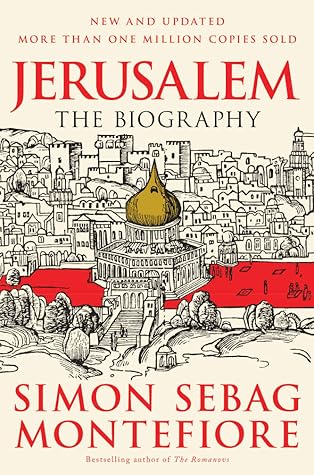More on this book
Community
Kindle Notes & Highlights
But the Jews somehow transformed this catastrophe into the formative experience that redoubled the sanctity of Jerusalem and created a prototype for the Day of Judgement. For all three religions, this inferno made Jerusalem the venue of the Last Days and the coming of the divine kingdom. This was the Apocalypse – based on the Greek word for ‘revelation’ – that Jesus would prophesy.
When the Roman envoy Popillius Laenas met the king in Alexandria, he brashly drew a circle in the sand around Antiochus, demanding he agree to withdraw from Egypt before stepping out of it – the origin of the phrase ‘draw a line in the sand’. Antiochus, ‘groaning and in bitterness of heart’, bowed before Roman power.
Octavian received him in Rhodes. Herod handled the meeting shrewdly and frankly. He humbly laid his diadem crown at Octavian’s feet. Then instead of disowning Antony, he asked Octavian not to consider whose friend he had been but ‘what sort of friend I am’.
Augustus was not amused. Knowing that Jews eschewed pork, he commented drily: ‘I’d rather be Herod’s pig than his son.’
Jesus left no writings and his teachings have been endlessly analysed, but the four Gospels reveal that the essence of his ministry was his warning of the imminent Apocalypse – Judgement Day and the Kingdom of Heaven.
During his ten years in Jamestown, he led the raid against the Algonquin native Americans during which he slaughtered a considerable number: Protestants were no less capable of killing defiant infidels than any other seventeenth-century faith.
‘I would found a religion’, he reflected with megalomaniacal arrogance, ‘I saw myself marching on the way to Asia, mounted on an elephant, a turban on my head, in one hand a new Koran I would have composed myself.’
‘I really wish the Jews again in Judaea an independent nation,’ wrote the second US president John Adams. In
Thackeray sensed ‘there’s not a spot at which you may look but where some violent deed has been done, some massacre, some visitors murdered, some idol worshipped with bloody rites.’
Standing at the Golden Gate, gazing out at Muslim and Jewish cemeteries, Melville saw a ‘city besieged by armies of the dead’ and asked himself: ‘is the desolation the result of the fatal embrace of the Deity?’
Jerusalem had at least two faces and a multiple personality disorder: the gleaming, imperial edifices, built by the Europeans in pith helmets and redcoats as they rapidly Christianized the Muslim Quarter, existed alongside the old Ottoman city where black Sudanese guards protected the Haram and guarded condemned prisoners whose heads still rolled in public executions.
The tourists, whether religious or secular, Christian or Jewish, Chateaubriand, Montefiore or Twain, were good at seeing where gods had stood but almost blind when it came to seeing the actual people who lived there. Throughout her history, Jerusalem existed in the imagination of devotees who lived faraway in America or Europe. Now that these visitors were arriving on steamships in their thousands, they expected to find the exotic and dangerous, picturesque and authentic images they had imagined with the help of their Bibles, their Victorian stereotypes of race, and, once they arrived, their
...more
The angry face of Yahweh is brooding over the hot rocks which have seen more holy murder, rape, and plunder than any other place on this earth. Arthur Koestler
It was certainly cynical but the promises to the Arabs and the Jews were both the result of short-term, ill-considered and urgent political expediency in wartime andneither would have been proffered in other circumstances.
Many now shared General Montgomery’s view that ‘The Jew murders the Arab and the Arabs murder the Jews and it will go on for the next 50 years in all probability.’
The mufti’s views are indefensible – but it is wrong to use them to claim that Arab nationalists were Hitlerite anti-Semites.
Day and night, the corridors and bars of the King David were so crowded with Egyptian, Lebanese, Syrian, Serbian, Greek and Ethiopian princelings, aristocrats, racketeers, courtiers, loafers, tycoons, pimps, gigolos, courtesans, film stars and Allied, Axis, Zionist and Arab spies, as well as officers and diplomats in French, British, Australian and American uniforms, that visitors had to fight their way through its corridors even to reach its bar and get the desired dry martini.
In fact, the Arab League, the organization of newly independent Arab states formed in 1945, was divided between the territorial ambitions and dynastic rivalries of its members. Abdullah,
‘Can we hold Jerusalem?’ Abdullah asked Glubb. ‘They’ll never take it, sir!’ ‘If you ever think the Jews will take Jerusalem, you tell me,’ said the king. ‘I’ll go there and die on the walls of the city.’
If nothing else, the bloodshed proves the visceral relevance of archaeology in Jerusalem: here, history lives, and people die for it. Both sides politicized their archaeology: history was paramount.
Jerusalem today lives in a state of schizophrenic anxiety. Jews and Arabs dare not venture into each other’s neighbourhoods; secular Jews avoid ultra-Orthodox who stone them for not resting on the Sabbath or for wearing disrespectful clothing; Jews fulfil their religious dreams and stir Muslim anxiety by praying on the Temple Mount; and the Christian sects keep brawling. The faces of Jerusalemites are tense, their voices are angry and one feels that everyone, even those of all three faiths who are convinced that they are fulfilling a divine plan, is unsure of what tomorrow will bring.


